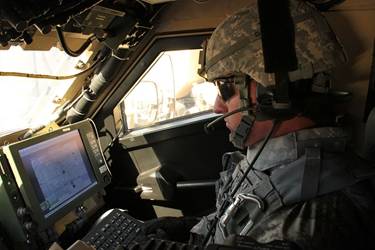ABERDEEN PROVING GROUND, MD. — After bringing a “one-two” punch of survivability and tactical mobility to the field in Afghanistan and Iraq, the Army’s combat-proven Stryker vehicle is now getting a high-speed network upgrade.
Known as Blue Force Tracking 2 (BFT 2), this next-generation satellite network provides faster position location and mapping information and secure data encryption, significantly increasing mission command on-the-move capabilities for Stryker brigade combat teams (SBCTs).
The Strykers are being converted from the line-of-sight, radio-based Enhanced Position Location Reporting System (EPLRS) to the faster and more easily managed, satellite-based BFT 2 network, which is being used today in Afghanistan as U.S. forces carry out advise-and-assist missions in support of the Afghan National Security Forces.
“BFT 2 untethers us from the line-of-sight network, so any place we have a formation, we’re able to actively receive communications,” said Maj. Dan Galvan, 2nd SBCT/2nd Infantry Division (2/2) brigade engineer. “This allows the brigade or battalion commanders to make on-time decisions and move forces more quickly to concentrate combat power.”
The BFT 2 conversion is the first part of a larger Capability Set (CS) fielding, which brings an integrated communications package to the 2/2 and 3rd SBCT/2nd Infantry Division (3/2), both based at Joint Base Lewis-McChord (JBLM), Washington.
Galvan said it was important to equip the 2/2 Strykers before they rotate to the National Training Center (NTC) in June.
“The terrain at the NTC breaks up line-of-sight communication,” Galvan said. “With the traditional FM radio or EPLRS, it requires a unit to go out and establish a retransmission (retrans) location. With BFT 2, we still will push out a retrans but we’re not as tied to that and we can still fight, operate and make timely decisions because it’s a satellite-based system. It extends the network far beyond what we could normally do in an EPLRS environment.”
The BFT network is used with the Army’s current and future situational awareness capability Force XXI Battle Command Brigade-and-Below (FBCB2), which is upgrading in two steps – Joint Capabilities Release (JCR) and Joint Battle Command-Platform (JBC-P). Primarily used in vehicles, FBCB2/BFT is currently integrated in more than 120,000 platforms, resides in each Tactical Operations Center and is fielded or authorized to every brigade combat team in the Army.
Approximately 20 percent of the Army is fielded JCR/BFT 2. With this recent delivery of JCR/BFT 2 to the 2/2 and 3/2, there are five remaining SBCTs to upgrade by the end of fiscal year 2015 or early fiscal year 2016. The Army will continue fielding the network to all Stryker units, retiring EPLRS as an FBCB2/JBC-P network mechanism by 2017.
The unprecedented undertaking meant converting both brigades’ fleets of more than 1,400 vehicles, including Strykers, High Mobility Multipurpose Wheeled Vehicle (HMMWV) platforms and other tactical vehicles, between March 1 and June 6.
“It’s been a full court press to get these first two units fielded in time for their next rotations,” said Thane C. St. Clair, chief of Product Distribution for Project Manager Mission Command. “Now that these units are equipped with JCR/BFT2, it simplifies their ability to communicate securely with other units, and enables them to more rapidly deploy since they no longer need to set up the terrestrial-based EPLRS network.”
This conversion was completed through a partnership between Product Manager JBC-P and Project Manager Stryker Brigade Combat Team.
“We wanted to convert the two units at the same time in order to maximize the resources and minimize the costs,” said Kevin Meehan, the head force integrator for JBLM. “Because we were doing two brigades back to back, it required the two project managers to work simultaneously and that has gone very well. Additionally, the Soldiers are all on board with this conversion. They understand the need for the upgrade and want the upgrade.”
The Army will continue to migrate the remaining five Stryker units to BFT 2, which provides a Global Positioning System (GPS) satellite for faster and more reliable and secure communications. Supporting the transition to a leaner, more agile Army, BFT 2 reduces the technical burden on Soldiers by operating on a centrally located and configured network, instead of requiring multiple vehicle-based EPLRS network managers and infrastructure
“The amount of terrain that SBCTs move in and operate in is much larger compared to an Infantry brigade combat team,” Meehan said. “A Stryker brigade moves faster and reacts quicker. BFT 2 gives them the flexibility and the ability to talk to each other anywhere in the world.”
The JCR/BFT 2 conversion for 2/2 and 3/2 is part of the Army’s fielding of CS 14. This integrated package of communications equipment includes not only BFT 2, but also Warfighter Information Network-Tactical (WIN-T) Increment 2, which provides on-the-move communications for the upper tactical internet. WIN-T allows added bandwidth for access to different types of data and capabilities.
Stryker integration with WIN-T Increment 2 is underway. First, it will be evaluated at a WIN-T Increment 2 developmental test at Fort Bliss, Texas in June. This will be followed by an evaluation by a full Stryker battalion during the semi-annual Network Integration Evaluation (NIE) 15.1 field exercises at Fort Bliss and White Sands Missile Range, N.M. in October. Lessons-learned from those assessments will inform continued CS fieldings to SBCTs.
Starting in fiscal year 2016 in accordance with the Army’s prioritization strategy, PM JBC-P will begin upgrading four EPLRS based Armored brigade combat teams (ABCT) with JCR/BFT 2 in a partnership with PM ABCT.

